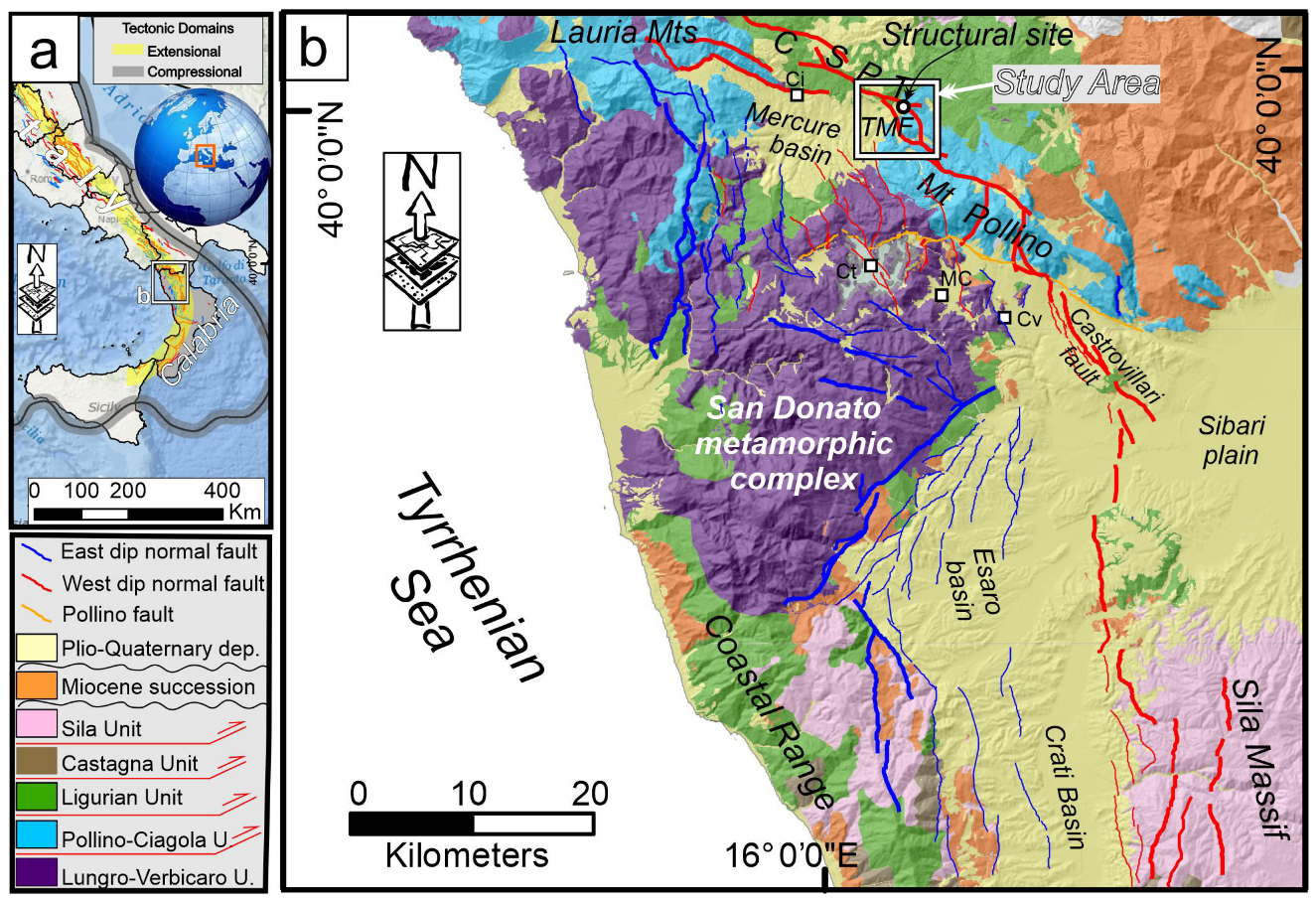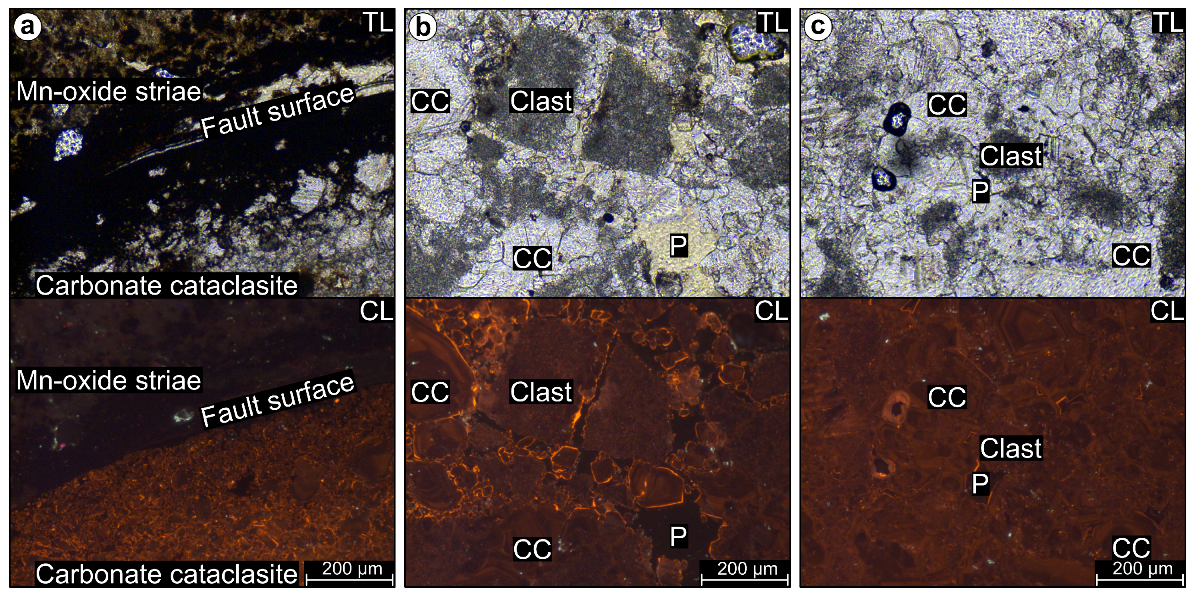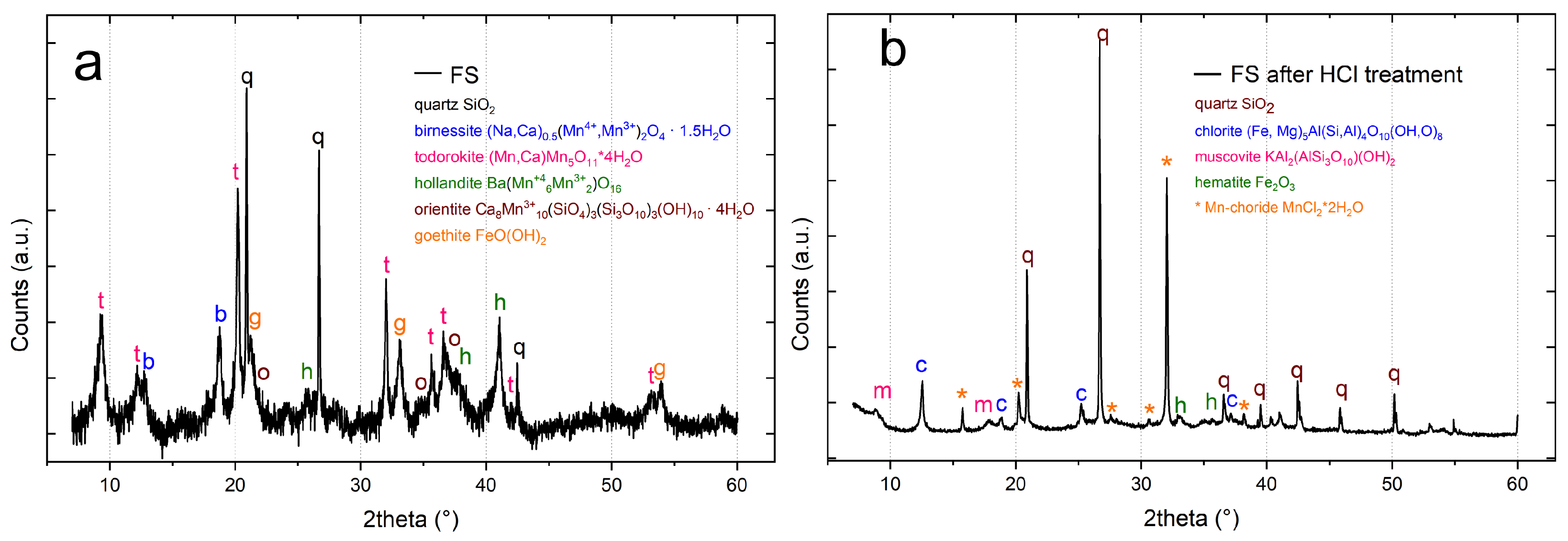Characterisation of Fault-Related Mn-Fe Striae on the Timpa Della Manca Fault (Mercure Basin, Southern Apennines, Italy)
Abstract
:1. Introduction

2. Structural–Geological Setting
The Timpa Della Manca Fault
3. Data and Methods
3.1. Analysed Sample
3.2. Microstructural Observations by Optical Microscopy and Cathodoluminescence
3.3. SEM
3.4. Powder X-Ray Diffraction
3.5. Micro-Raman
3.6. Thermodynamic Calculation
4. Results
4.1. Microstructural Features of the Fault Rock
4.2. Chemical and Structural Characterisation
- Birnessite ((Na,Ca)0.5(Mn+4,Mn+3)2)O4 1.5 H2O).
- Todorokite ((Na,Ca,K,Ba,Sr)1−x (Mn,Mg,Al)6O12 3-4 H2O).
- Hollandite (Ba(Mn+46Mn+32)O16).
- Orientite (Ca8Mn+310(SiO4)3(Si3O10)3(OH)10 4 H2O).
- Goethite Fe+3O(OH).
5. Discussion
6. Conclusions
Author Contributions
Funding
Data Availability Statement
Acknowledgments
Conflicts of Interest
References
- Bello, S.; de Nardis, R.; Scarpa, R.; Brozzetti, F.; Cirillo, D.; Ferrarini, F.; Di Lieto, B.; Arrowsmith, R.J.; Lavecchia, G. Fault pattern and seismotectonic style of the Campania–Lucania 1980 earthquake (Mw 6.9, Southern Italy): New multidisciplinary constraints. Front. Earth Sci. 2021, 8, 608063. [Google Scholar] [CrossRef]
- Bello, S.; Lavecchia, G.; Andrenacci, C.; Ercoli, M.; Cirillo, D.; Carboni, F.; Barchi, M.R.; Brozzetti, F. Complex trans-ridge normal faults controlling large earthquakes. Sci. Rep. 2022, 12, 10676. [Google Scholar] [CrossRef] [PubMed]
- Brozzetti, F.; Cirillo, D.; de Nardis, R.; Cardinali, M.; Lavecchia, G.; Orecchio, B.; Presti, D.; Totaro, C. Newly identified active faults in the Pollino seismic gap, southern Italy, and their seismotectonic significance. J. Struct. Geol. 2017, 94, 13–31. [Google Scholar] [CrossRef]
- Cirillo, D.; Totaro, C.; Lavecchia, G.; Orecchio, B.; de Nardis, R.; Presti, D.; Ferrarini, F.; Bello, S.; Brozzetti, F. Structural complexities and tectonic barriers controlling recent seismic activity of the Pollino area (Calabria-Lucania, Southern Italy)–constraints from stress inversion and 3D fault model building. Solid Earth Discuss. 2021, 13, 205–228. [Google Scholar] [CrossRef]
- Lavecchia, G.; Bello, S.; Andrenacci, C.; Cirillo, D.; Pietrolungo, F.; Talone, D.; Ferrarini, F.; de Nardis, R.; Galli, P.; Faure Walker, J.; et al. QUIN 2.0-new release of the QUaternary fault strain INdicators database from the Southern Apennines of Italy. Sci. Data 2024, 11, 189. [Google Scholar] [CrossRef]
- Brozzetti, F.; Lavecchia, G.; Mancini, G.; Milana, G.; Cardinali, M. Analysis of the 9 September 1998 Mw 5.6 Mercure earthquake sequence (Southern Apennines, Italy): A multidisciplinary approach. Tectonophysics 2009, 476, 210–225. [Google Scholar] [CrossRef]
- Totaro, C.; Seeber, L.; Waldhauser, F.; Steckler, M.; Gervasi, A.; Guerra, I.; Orecchio, B.; Presti, D. An intense earthquake swarm in the southernmost Apennines: Fault architecture from high-resolution hypocenters and focal mechanisms. Bull. Seismol. Soc. Am. 2015, 105, 3121–3128. [Google Scholar] [CrossRef]
- Papanikolaou, I.D.; Roberts, G.P. Geometry, kinematics and deformation rates along the active normal fault system in the southern Apennines: Implications for fault growth. J. Struct. Geol. 2007, 29, 166–188. [Google Scholar] [CrossRef]
- Brozzetti, F. The Campania-Lucania Extensional Fault System, southern Italy: A suggestion for a uniform model of active extension in the Italian Apennines. Tectonics 2011, 30(5). [Google Scholar] [CrossRef]
- Lavecchia, G.; Ferrarini, F.; Brozzetti, F.; De Nardis, R.; Boncio, P.; Chiaraluce, L. From surface geology to aftershock analysis: Constraints on the geometry of the L’Aquila 2009 seismogenic fault system. Ital. J. Geosci. 2012, 131, 330–347. [Google Scholar] [CrossRef]
- Lavecchia, G.; Bello, S.; Andrenacci, C.; Cirillo, D.; Ferrarini, F.; Vicentini, N.; de Nardis, R.; Roberts, G.; Brozzetti, F. QUaternary fault strain INdicators database-QUIN 1.0-first release from the Apennines of central Italy. Sci. Data 2022, 9, 204. [Google Scholar] [CrossRef] [PubMed]
- Falini, F. Notizie Preliminari sui Lavori di Rilevamento di Dettaglio dalle Caratteristiche del Giacimento Lignitifero del Mercure (Provincie di Potenza e Cosenza). Convegno-Mostra Nazionale delle Ligniti; Multilith dalla Siderea: Rome, Italy, 1955. [Google Scholar]
- GEMINA. Il bacino del Mercure Torino, Italy,; 1963; pp. 137–156. In Ligniti e Torbe Dell’Italia Continentale; Ilte: Torino, Italy, 1963; pp. 137–156. [Google Scholar]
- Giaccio, B.; Galli, P.; Peronace, E.; Arienzo, I.; Nomade, S.; Cavinato, G.P.; Mancini, M.; Messina, P.; Sottili, G. A 560–440 ka tephra record from the Mercure Basin, southern Italy: Volcanological and tephrostratigraphic implications. J. Quat. Sci. 2014, 29, 232–248. [Google Scholar] [CrossRef]
- Schiattarella, M.; Torrente, M.; Russo, F. Analisi strutturale ed osservazioni morfostratigrafiche nel bacino del Mercure (confine calabro-lucano). Il Quat. Ital. J. Quat. Sci. 1994, 7, 613–626. [Google Scholar]
- Ercoli, M.; Cirillo, D.; Pauselli, C.; Jol, H.M.; Brozzetti, F. Ground-penetrating radar signature of Quaternary faulting: A study from the Mt. Pollino region, southern Apennines, Italy. Solid Earth 2021, 12, 2573–2596. [Google Scholar] [CrossRef]
- Robustelli, G.; Ermolli, E.R.; Petrosino, P.; Jicha, B.; Sardella, R.; Donato, P. Tectonic and climatic control on geomorphological and sedimentary evolution of the Mercure basin, southern Apennines, Italy. Geomorphology 2014, 214, 423–435. [Google Scholar] [CrossRef]
- Brozzetti, F.; Cirillo, D.; Liberi, F.; Piluso, E.; Faraca, E.; De Nardis, R.; Lavecchia, G. Structural style of Quaternary extension in the Crati Valley (Calabrian Arc): Evidence in support of an east-dipping detachment fault. Ital. J. Geosci. 2017, 136, 434–453. [Google Scholar] [CrossRef]
- Galli, P.; Molin, D.; Camassi, R.; Castelli, V. Il terremoto del 9 settembre 1998 nel quadro della sismicità storica del confine calabro-lucano. Possibili implicazioni sismotettoniche. Il Quat. Ital. J. Quat. Sci. 2001, 14, 31–40. [Google Scholar]
- Cinti, F.R.; Cucci, L.; Pantosti, D.; D’Addezio, G.; Meghraoui, M. A major seismogenic fault in a ‘silent area’: The Castrovillari fault (southern Apennines, Italy). Geophys. J. Int. 1997, 130, 595–605. [Google Scholar] [CrossRef]
- Cinti, F.; Moro, M.; Pantosti, D.; Cucci, L.; D’addezio, G. New constraints on the seismic history of the Castrovillari fault in the Pollino gap (Calabria, southern Italy). J. Seismol. 2002, 6, 199–217. [Google Scholar] [CrossRef]
- Knott, S.D. The Liguride complex of southern Italy—A Cretaceous to Paleogene accretionary wedge. Tectonophysics 1987, 142, 217–226. [Google Scholar] [CrossRef]
- Tangari, A.C.; Scarciglia, F.; Piluso, E.; Marinangeli, L.; Pompilio, L. Role of weathering of pillow basalt, pyroclastic input and geomorphic processes on the genesis of the Monte Cerviero upland soils (Calabria, Italy). CATENA 2018, 171, 299–315. [Google Scholar] [CrossRef]
- Monaco, C.; Tortorici, L. Tectonic role of ophiolite-bearing terranes in the development of the Southern Apennines orogenic belt. Terra Nova 1995, 7, 153–160. [Google Scholar] [CrossRef]
- Filice, F.; Liberi, F.; Cirillo, D.; Pandolfi, L.; Marroni, M.; Piluso, E. Geology map of the central area of Catena Costiera: Insights into the tectono-metamorphic evolution of the Alpine belt in Northern Calabria. J. Maps 2015, 11, 114–125. [Google Scholar] [CrossRef]
- Marinangeli, L.; Pompilio, L.; Baliva, A.; Billotta, S.; Bonanno, G.; Domeneghetti, M.C.; Fioretti, A.M.; Menozzi, O.; Nestola, F.; Piluso, E.; et al. Development of an ultra-miniaturised XRD/XRF instrument for the in situ mineralogical and chemical analysis of planetary soils and rocks: Implication for archaeometry. Rend. Lincei 2015, 26, 529–537. [Google Scholar] [CrossRef]
- Bethke, C.; Yeakel, S. The Geochemist’s Workbench Release 7.0—Essentials Guide; Hydrogeology Program, University of Illinois: Urbana, IL, USA, 2008. [Google Scholar]
- Shvarov, Y.V. HCh: New potentialities for the thermodynamic simulation of geochemical systems offered by Windows. Geochem. Int. 2008, 46, 834. [Google Scholar] [CrossRef]
- Cleverley, J.S.; Bastrakov, E.N. K2GWB: Utility for generating thermodynamic data files for the Geochemist’s Workbench® at 0–1000 C and 1–5000 bar from UT2K and the UNITHERM database. Comput. Geosci. 2005, 31, 756–767. [Google Scholar] [CrossRef]
- Robie, R.A.; Huebner, J.S.; Hemingway, B.S. Heat capacities and thermodynamic properties of braunite (Mn7SiO12) and rhodonite (MnSiO3). Am. Mineral. 1995, 80, 560–575. [Google Scholar] [CrossRef]
- Jacob, K.; Kumar, A.; Waseda, Y. Gibbs energy of formation of MnO: Measurement and assessment. J. Phase Equilibria Diffus. 2008, 29, 222–230. [Google Scholar] [CrossRef]
- Jacob, K.; Kumar, A.; Rajitha, G.; Waseda, Y. Thermodynamic data for mn3o4, mn2o3 and mno2. High Temp. Mater. Process. 2011, 30, 459–472. [Google Scholar] [CrossRef]
- Wolery, T.W.; Jarek, R.L. Software user’s manual. EQ3/6 Version 2003, 8, 376. [Google Scholar]
- Roine, A. HSC Chemistry® 7.0 User’s Guide–Volume 1/2–Chemical Reaction and Equilibrium Software with Extensive Thermochemical Database and Flowsheet Simulation; Outotec Information Center: Pori, Finland, 2009. [Google Scholar]
- Blanc, P.; Lassin, A.; Piantone, P.; Burnol, A. Thermoddem a Database Devoted to Waste Minerals; Bureau de Recherches Géologiques et Minieres (Orléans, France): Orléans, France, 2007. [Google Scholar]
- Johnson, J.W.; Oelkers, E.H.; Helgeson, H.C. SUPCRT92: A software package for calculating the standard molal thermodynamic properties of minerals, gases, aqueous species, and reactions from 1 to 5000 bar and 0 to 1000 C. Comput. Geosci. 1992, 18, 899–947. [Google Scholar] [CrossRef]
- Post, J.E. Manganese oxide minerals: Crystal structures and economic and environmental significance. Proc. Natl. Acad. Sci. USA 1999, 96, 3447–3454. [Google Scholar] [CrossRef] [PubMed]
- Potter, R.M.; Rossman, G.R. Mineralogy of manganese dendrites and coatings. Am. Mineral. 1979, 64, 1219–1226. [Google Scholar]
- Robb, L. Introduction to Ore-Forming Processes; John Wiley & Sons: Hoboken, NJ, USA, 2020. [Google Scholar]
- Sibson, R.H. Arterial faults and their role in mineralizing systems. Geosci. Front. 2019, 10, 2093–2100. [Google Scholar] [CrossRef]
- Spencer, J.E.; Welty, J.W. Possible controls of base-and precious-metal mineralization associated with Tertiary detachment faults in the lower Colorado River trough, Arizona and California. Geology 1986, 14, 195–198. [Google Scholar] [CrossRef]
- Calegari, S.S.; Aiolfi, T.R.; Neves, M.A.; Soares, C.C.V.; Marques, R.d.A.; Caxito, F.d.A. Filling materials in brittle structures as indicator of Cenozoic tectonic events in Southeastern Brazil. Anu. Inst. Geociencias 2020, 43, 237–254. [Google Scholar] [CrossRef]
- Jones, S.; McNaughton, N.J.; Grguric, B. Structural controls and timing of fault-hosted manganese at Woodie Woodie, East Pilbara, Western Australia. Ore Geol. Rev. 2013, 50, 52–82. [Google Scholar] [CrossRef]
- Krauskopf, K.B. Separation of manganese from iron in sedimentary processes. Geochim. Cosmochim. Acta 1957, 12, 61–84. [Google Scholar] [CrossRef]
- Hewett, D. Manganite, hausmannite, braunite; features, modes of origin. Econ. Geol. 1972, 67, 83–102. [Google Scholar] [CrossRef]
- Julien, C.; Massot, M.; Poinsignon, C. Lattice vibrations of manganese oxides: Part I. Periodic structures. Spectrochim. Acta Part Mol. Biomol. Spectrosc. 2004, 60, 689–700. [Google Scholar] [CrossRef]
- Vermeersch, E.; Košek, F.; De Grave, J.; Jehlička, J.; Vandenabeele, P.; Rousaki, A. Identification of tunnel structures in manganese oxide minerals using micro-Raman spectroscopy. J. Raman Spectrosc. 2023, 54, 1201–1212. [Google Scholar] [CrossRef]
- Vermeersch, E.; Košek, F.; De Grave, J.; Jehlička, J.; Rousaki, A. Layered manganese oxides structures: Micro-Raman and selected mobile Raman spectroscopic studies. J. Raman Spectrosc. 2024, 55, 246–262. [Google Scholar] [CrossRef]
- McKeown, D.A.; Post, J.E. Characterization of manganese oxide mineralogy in rock varnish and dendrites using X-ray absorption spectroscopy. Am. Mineral. 2001, 86, 701–713. [Google Scholar] [CrossRef]
- Mc Kenzie, R.M. Manganese oxides and hydroxides. Miner. Soil Environ. 1989, 1, 439–465. [Google Scholar] [CrossRef]
- Comodi, P.; Nazzareni, S.; Zanazzi, P.F.; Speziale, S. High-pressure behavior of gypsum: A single-crystal X-ray study. Am. Mineral. 2008, 93, 1530–1537. [Google Scholar] [CrossRef]
- Nazzareni, S.; Comodi, P.; Bindi, L.; Garbarino, G.; Bobrov, A. Equation of state of Fe 3+-bearing phase-X. Phys. Chem. Miner. 2012, 39, 553–559. [Google Scholar] [CrossRef]
- Yun, S.; Hwang, H.; Hwang, G.; Kim, Y.; Blom, D.; Vogt, T.; Post, J.E.; Jeon, T.Y.; Shin, T.J.; Zhang, D.Z.; et al. Super-hydration and reduction of manganese oxide minerals at shallow terrestrial depths. Nat. Commun. 2022, 13, 1942. [Google Scholar] [CrossRef]
- Tutti, F.; Dubrovinsky, L.S.; Saxena, S.K.; Carlson, S. Stability of KAlSi3O8 Hollandite-type structure in the Earth’s lower mantle conditions. Geophys. Res. Lett. 2001, 28, 2735–2738. [Google Scholar] [CrossRef]
- Galli, P.; Galadini, F.; Pantosti, D. Twenty years of paleoseismology in Italy. Earth-Sci. Rev. 2008, 88, 89–117. [Google Scholar] [CrossRef]
- Bello, S.; Perna, M.G.; Consalvo, A.; Brozzetti, F.; Galli, P.; Cirillo, D.; Andrenacci, C.; Tangari, A.C.; Carducci, A.; Menichetti, M.; et al. Coupling rare earth element analyses and high-resolution topography along fault scarps to investigate past earthquakes: A case study from the Southern Apennines (Italy). Geosphere 2023, 19, 1348–1371. [Google Scholar] [CrossRef]
- Marchesini, M.; Pagano, R. The Val Graveglia manganese district, Liguria, Italy. Mineral. Rec. 2001, 32, 349. [Google Scholar]
- Mongelli, G.; Critelli, S.; Dinelli, E.; Paternoster, M.; Perri, F. Mn-and Fe-carbonate rich layers in Meso-Cenozoic shales as proxies of environmental conditions: A case study from the southern Apennine, Italy. Geochem. J. 2010, 44, 211–223. [Google Scholar] [CrossRef]
- Caine, J.S.; Bruhn, R.L.; Forster, C.B. Internal structure, fault rocks, and inferences regarding deformation, fluid flow, and mineralization in the seismogenic Stillwater normal fault, Dixie Valley, Nevada. J. Struct. Geol. 2010, 32, 1576–1589. [Google Scholar] [CrossRef]
- Sibson, R.; Moore, J.M.M.; Rankin, A. Seismic pumping—A hydrothermal fluid transport mechanism. J. Geol. Soc. 1975, 131, 653–659. [Google Scholar] [CrossRef]
- Salvioli-Mariani, E.; Boschetti, T.; Vescovi, F.M.; Scacchetti, M.; Toscani, L.; Mattioli, M. Hydrothermal lead-zinc-copper mineralizations in sedimentary rocks of Northern Apennines (Italy). J. Geochem. Explor. 2024, 257, 107365. [Google Scholar] [CrossRef]
- Hönisch, B.; Ridgwell, A.; Schmidt, D.N.; Thomas, E.; Gibbs, S.J.; Sluijs, A.; Zeebe, R.; Kump, L.; Martindale, R.C.; Greene, S.E.; et al. The geological record of ocean acidification. Science 2012, 335, 1058–1063. [Google Scholar] [CrossRef]
- Napolitano, F.; Gabrielli, S.; De Siena, L.; Amoroso, O.; Capuano, P. Imaging overpressurised fracture networks and geological barriers hindering fluid migrations across a slow-deformation seismic gap. Sci. Rep. 2023, 13, 19680. [Google Scholar] [CrossRef]
- Smeraglia, L.; Bernasconi, S.M.; Berra, F.; Billi, A.; Boschi, C.; Caracausi, A.; Carminati, E.; Castorina, F.; Doglioni, C.; Italiano, F.; et al. Crustal-scale fluid circulation and co-seismic shallow comb-veining along the longest normal fault of the central Apennines, Italy. Earth Planet. Sci. Lett. 2018, 498, 152–168. [Google Scholar] [CrossRef]
- Talone, D.; De Siena, L.; Lavecchia, G.; de Nardis, R. The Attenuation and Scattering Signature of Fluid Reservoirs and Tectonic Interactions in the Central-Southern Apennines (Italy). Geophys. Res. Lett. 2023, 50, e2023GL106074. [Google Scholar] [CrossRef]
- de Nardis, R.; Vuan, A.; Carbone, L.; Talone, D.; Romano, M.A.; Lavecchia, G. Interplay of tectonic and dynamic processes shaping multilayer extensional system in southern-central Apennines. Sci. Rep. 2024, 14, 18375. [Google Scholar] [CrossRef]
- Long, K. Descriptive model of detachment-fault-related mineralization. Dev. Miner. Depos. Model. Geol. Surv. Bull. 1992, 2004, 57–62. [Google Scholar]







| Elements | Sursassite | Hollandite | Barite + Calcite | Mix Mn-Fe Phases | Orientite +Mn-Phase | Chlorite |
|---|---|---|---|---|---|---|
| O | 41.11 | 27.76 | 29.07 | 32.14 | 32.84 | 46.39 |
| Mg | 1.81 | 1.35 | 1.67 | 3.28 | 14.86 | |
| Al | 15.09 | 4.43 | 0.86 | 3.69 | 7.59 | 5.76 |
| Si | 16.46 | 4.99 | 1.55 | 7.45 | 7.61 | 24.69 |
| S | 3.38 | |||||
| K | 0.86 | 0.55 | 1.12 | |||
| Ca | 3.5 | 2.36 | 49.14 | 3.21 | 7.71 | 7.04 |
| Ti | 0.43 | |||||
| Mn | 21.15 | 41.53 | 22.96 | 37.43 | ||
| Fe | 6.74 | 25.35 | 1.4 | 1.25 | ||
| Ni | 0.57 | |||||
| Ba | 10.3 | 16 | 3.54 | |||
| Total | 100 | 100 | 100 | 100 | 100 | 100 |
| Sample Point | Frequencies | |||||
|---|---|---|---|---|---|---|
| S2 | 488.8 | 598.4 | 665.0 | 905.9 | 1085.6 | |
| S5 | 483.7 | 599.0 | 609.9 | |||
| S8 | 483.4 | 583.7 | 596.0 | 628.3 | 946.9 | |
Disclaimer/Publisher’s Note: The statements, opinions and data contained in all publications are solely those of the individual author(s) and contributor(s) and not of MDPI and/or the editor(s). MDPI and/or the editor(s) disclaim responsibility for any injury to people or property resulting from any ideas, methods, instructions or products referred to in the content. |
© 2024 by the authors. Licensee MDPI, Basel, Switzerland. This article is an open access article distributed under the terms and conditions of the Creative Commons Attribution (CC BY) license (https://creativecommons.org/licenses/by/4.0/).
Share and Cite
Nazzareni, S.; Mantovani, L.; Pizzati, M.; Bersani, D.; Boschetti, T.; Palmucci, A.; Cirillo, D.; Brozzetti, F. Characterisation of Fault-Related Mn-Fe Striae on the Timpa Della Manca Fault (Mercure Basin, Southern Apennines, Italy). Geosciences 2024, 14, 299. https://doi.org/10.3390/geosciences14110299
Nazzareni S, Mantovani L, Pizzati M, Bersani D, Boschetti T, Palmucci A, Cirillo D, Brozzetti F. Characterisation of Fault-Related Mn-Fe Striae on the Timpa Della Manca Fault (Mercure Basin, Southern Apennines, Italy). Geosciences. 2024; 14(11):299. https://doi.org/10.3390/geosciences14110299
Chicago/Turabian StyleNazzareni, Sabrina, Luciana Mantovani, Mattia Pizzati, Danilo Bersani, Tiziano Boschetti, Ambra Palmucci, Daniele Cirillo, and Francesco Brozzetti. 2024. "Characterisation of Fault-Related Mn-Fe Striae on the Timpa Della Manca Fault (Mercure Basin, Southern Apennines, Italy)" Geosciences 14, no. 11: 299. https://doi.org/10.3390/geosciences14110299
APA StyleNazzareni, S., Mantovani, L., Pizzati, M., Bersani, D., Boschetti, T., Palmucci, A., Cirillo, D., & Brozzetti, F. (2024). Characterisation of Fault-Related Mn-Fe Striae on the Timpa Della Manca Fault (Mercure Basin, Southern Apennines, Italy). Geosciences, 14(11), 299. https://doi.org/10.3390/geosciences14110299









